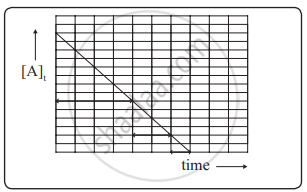Advertisements
Advertisements
Question
Answer the following in brief.
How will you represent the zeroth-order reaction graphically?
Solution
Graphical representation of zero-order reactions: The rate law is given as

which is a straight line given by y = mx + c.
A plot of `["A"]_"t"` versus t is a straight line.

[A]t vs t for zero-order reaction
The slope of the straight line is -k and its intercept on the y-axis is `["A"]_0`.
APPEARS IN
RELATED QUESTIONS
Answer the following in one or two sentences.
What are the units for rate constants for zero-order and second-order reactions if time is expressed in seconds and concentration of reactants in mol/L?
Answer the following in brief.
Obtain the relationship between the rate constant and half-life of a first-order reaction.
Answer the following in brief.
Derive the integrated rate law for the first-order reaction,
\[\ce{A_{(g)} -> B_{(g)} + C_{(g)}}\] in terms of pressure.
Answer the following in brief.
What is a zeroth-order reaction?
Solve
In a first-order reaction, the concentration of the reactant decreases from 20 mmol dm-3 to 8 mmol dm-3 in 38 minutes. What is the half-life of reaction?
Answer the following in brief.
What are the units of the rate constant?
The rate of catalysed reaction is large than the uncatalysed reaction as _______.
Give one example of pseudo first-order reaction.
Write a mathematical expression for integrated rate law for zero-order reaction.
What is half life of first order reaction if time required to decrease concentration of reactants from 0.8 M to 0.2 M is 12 hours?
Explain pseudo first order reaction with a suitable example.
In a first order reaction \[\ce{x -> y}\]; if k is the rate constant and the initial concentration of the reactant x is 0.1 M, then, the half life is
Assertion: rate of reaction doubles when the concentration of the reactant is doubles if it is a first-order reaction.
Reason: rate constant also doubles.
Write the rate law for the following reaction.
A reaction that is second order in NO and first order in Br2.
From the following data, show that the decomposition of hydrogen peroxide is a reaction of the first order:
| t (min) | 0 | 10 | 20 |
| V (ml) | 46.1 | 29.8 | 19.3 |
Where t is the time in minutes and V is the volume of standard KMnO4 solution required for titrating the same volume of the reaction mixture.
A first order reaction is 25% completed in 40 minutes. What is the rate constant k tor the reaction?
The integrated rate equation for first-order reaction, A → product, is ______.
Half-life period of a first order reaction, \[\ce{A -> product}\] is 3.0 hours. What is the value of rate constant?
Reaction given below follows first order kinetics:
\[\ce{2N2O2 -> 4NO2 + O2}\]
Calculate the rate constant of reaction if concentration of N2O2 is 0.05 M and rate of reaction is 1.5 × 10−6 mol L−1 s−1?
The initial concentration of reactant (A) is 2 mol dm−3 for a zero order reaction \[\ce{A -> B}\]. The rate constant (k) is related to its half-life `("t"_(1//2))` by the equation:
Which among the following is an example of pseudo first order reaction?
A first order reaction is 50% completed in 16 minutes. The percentage of reactant that will react in 32 minutes is ____________.
The time required to decompose SO2Cl2 to half of it's initial amount is 60 minutes. Calculate rate constant for this first order reaction.
Rate constant for zero order reaction is 2 × 10-2 mol L-1 s-1. If the concentration of the reactant after 25 sec. is 0.5 M, what is the initial concentration of reactant?
The integrated rate law is a direct relationship between time and ______
The rate constant and half-life of a first order reaction are related to each other as ______.
A radioactive isotope decayed to 17/32 of its original mass after 60 minutes. Find the half-life of this radioisotope.
What is the rate constant of a first order reaction if 0.08 mole of reactant reduces to 0.02 mole in 23.03 minutes?
